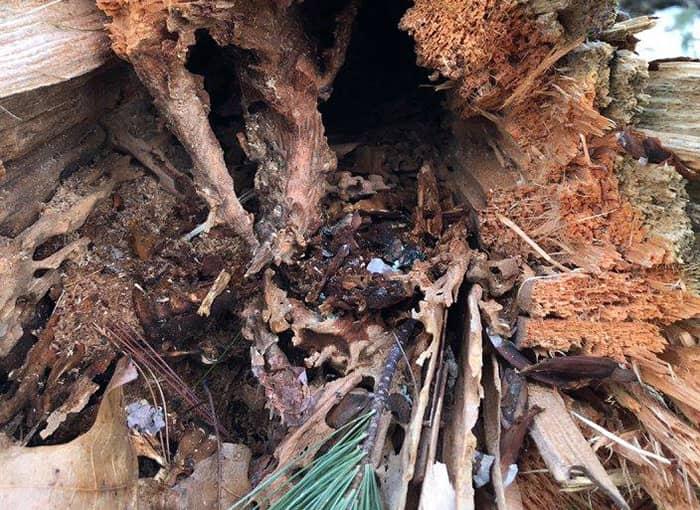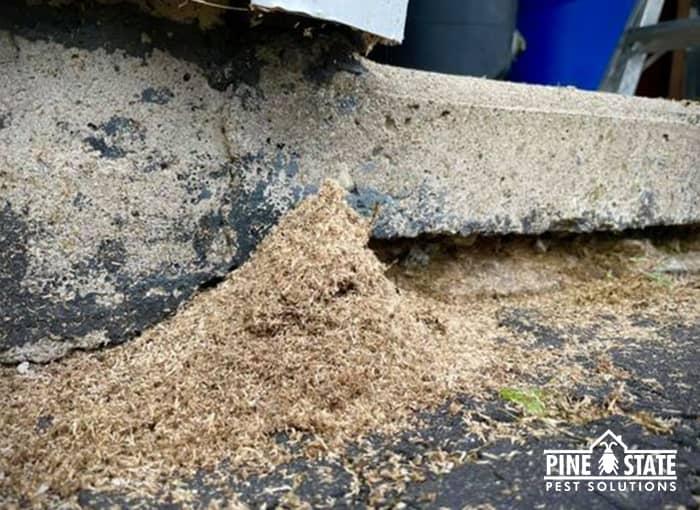What do carpenter ants look like?
Carpenter ants are known for their large size. Worker adults can grow up to ½ an inch in length, and queens can grow even larger - up to an inch. Their exact coloring depends on the species; but, in general, carpenter ants are black, red, yellow, or a combination of both black and red. They have a one-node waist, and the workers have very strong mandibles that they use to tunnel through wood.

Are carpenter ants dangerous?
Carpenter ants are not dangerous to people or pets; but they are dangerous to the structural integrity of your home. Carpenter ants will damage wood as they create intricate tunnels and nesting areas.
Do carpenter ants eat wood?
Carpenter ants do not feed on the wood that they are tunneling through; they are simply creating nesting areas within the wood. Carpenter ants do feed on a variety of food sources including other insects, honeydew from aphids, and sweets and other human foods they find while foraging in kitchens.
Are carpenter ants destructive?
If carpenter ants are left untreated, their tunneling can create significant damage that can weaken structures. These large black ants may initially be attracted to and infest water damaged wood, but they will eventually expand their efforts to healthy wood. Damages can be quite significant, time consuming, and costly to repair.
The picture below shows just what carpenter ants are capable of. This tree in Auburn, Maine had been infested and damaged by these wood-destroying ants.

Where do carpenter ants build nests?
Carpenter ants tend to establish nests in damp or decaying wood, often in areas with a high moisture content. Tree stumps, rotting logs, and old landscape timbers are common nesting sites outdoors. Inside, carpenter ants often build nests inside walls, door casings, sills, porch pillars, and crawlspaces. They are also frequently found in bathrooms, kitchens, and laundry rooms.
How do I know if I have a carpenter ant infestation?
The most tell-tale sign of an infestation is finding workers foraging in and around your home. You may also see winged reproductive members flying around after they have emerged from the colony to mate and start a new colony of their own. In the case of a large carpenter ant infestation, you may hear rusting or chewing noises coming from behind the walls.
Find piles of wood shavings on the floor underneath walls or other wooden items (see images below) is another sign of a carpenter ant problem.


How do I get rid of carpenter ants?
Pine State Pest Solutions has been getting rid of carpenter ants in Auburn, Portland, and Augusta as well as throughout our Maine service area for over 10 years. If you've discovered carpenter ants in or around your home, we are ready to help! Offering one-time carpenter ant treatments, bi-annual carpenter ant control and ongoing protection, our team is ready to keep carpenter ants away from your home.
 Ongoing pest control that protects against carpenter ants & other pests
Ongoing pest control that protects against carpenter ants & other pests
Pricing starting as low as $35/month
Pine State’s Home Protection is an affordable pest control plan that is ideal for homeowners who want general pest control services that target common house-infesting insects and rodents.
When you sign up for this ongoing service, you’ll receive an initial service visit to treat the existing pest problem and then seasonal service visits spread out over the year to ensure pests stay out. That’s a total of four services annually.
Pests covered under Pine State’s Home Protection plan include carpenter ants, cornfield ants, crazy ants, field ants, little black ants, pavement ants, Asian lady beetles, carpet beetles, cigarette beetles, drugstore beetles, flour beetles, ground beetles, hide beetles, larder beetles, saw-toothed grain beetles, warehouse beetles, boxelder bugs, carpenter bees, centipedes, clover mites, American cockroaches, brown-banded cockroaches, wood cockroaches, field crickets, house crickets, European earwigs, firebrats, cluster flies, fruit flies, bald-faced hornets, European hornets, deer mice, house mice, millipedes, Angoumois grain moths, drain moths, Indian meal moths, Mediterranean flour moths, mud daubers, Norway rats, paper wasps, pill bugs, rice weevils, silverfish, sow bugs, springtails, cellar spiders, daddy longlegs spiders, house spiders, jumping spiders, sac spiders, wolf spiders, Western confider seed bugs, and yellow jackets.
*Some exclusions apply- please see your agreement
How do I prevent a carpenter ant problem?
The best way to prevent carpenter ants from infesting your property is to eliminate the conditions that are attracting them. To that end, our team recommends the following carpenter ant prevention tips:
-
Reduce moisture around your home by fixing leaky faucets and pipes indoors and out. Also, make sure that gutters are not clogged by leaves and other debris and are properly directing water away from your foundation.
-
Replace any water damaged wood.
-
Use dehumidifiers in basements and crawl spaces.
-
Store firewood away from the outside of your home.
-
Trim trees and shrubs away from the exterior of your home.
-
Caulk gaps found around windows and doors; seal cracks in the foundation.
-
Store food properly.
-
Clean up spills and crumbs especially in kitchen and pantry areas.
Pine State Pest Solutions serves the following counties, Kennebec, Androscoggin, Sagadahoc, Oxford, Cumberland and York. See a complete list of areas we serve in Maine.
Related Articles
Warning Signs Of A Carpenter Ant Infestation
A Guide To Carpenter Ants In Maine
The Different Types Of Ants In Maine
